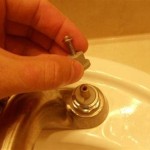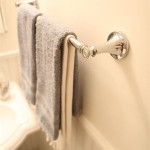Bathroom Vanity Without Backsplash: A Contemporary Design Choice
Bathroom vanities without backsplashes are gaining popularity in modern bathroom design. This minimalist approach offers a clean, streamlined look and provides homeowners with increased design flexibility. By foregoing the traditional backsplash, the wall behind the vanity becomes a blank canvas, allowing for a variety of creative finishes and design elements.
Seamless and Streamlined Aesthetics
The absence of a backsplash creates a seamless transition between the vanity and the wall, contributing to a more spacious and less cluttered feel. This is particularly advantageous in smaller bathrooms, where visual continuity can maximize the perception of space. The uninterrupted lines create a sleek, contemporary aesthetic that complements modern design sensibilities.
Enhanced Design Flexibility
Eliminating the backsplash opens up numerous design possibilities for the wall behind the vanity. Homeowners can explore various materials, textures, and colors to personalize their bathroom. Options include textured wallpaper, decorative tile, unique paint finishes, or even exposed brick for an industrial chic look.
Easier Cleaning and Maintenance
While backsplashes protect the wall from water splashes, they also introduce grout lines and crevices that can trap dirt and mildew. A vanity without a backsplash simplifies cleaning routines. The smooth, uninterrupted surface of the wall can be easily wiped down, eliminating the need for meticulous grout scrubbing.
Cost-Effective Option
Removing the backsplash from the vanity installation can reduce overall project costs. The materials and labor associated with installing a backsplash are eliminated, offering potential savings that can be allocated to other bathroom upgrades or design features.
Spotlight on Wall Treatments
A vanity without a backsplash provides an opportunity to showcase unique wall treatments. The wall becomes a focal point, allowing homeowners to express their personal style and create a visually striking bathroom. Bold patterns, vibrant colors, or textured materials can be used to create a statement piece.
Considerations for Moisture Protection
While a backsplash offers direct protection from water splashes, alternative methods can be employed to protect the wall behind a vanity without a backsplash. A high-quality, moisture-resistant paint is essential. Applying a sealant to the wall can provide additional protection against water damage. Careful consideration should also be given to the placement of faucets and the water pressure to minimize splashing.
Creative Material Choices
The exposed wall behind a vanity without a backsplash presents a unique opportunity to explore various materials. Large format tiles, with minimal grout lines, can create a sophisticated and low-maintenance surface. Natural stone, such as marble or granite, can add a touch of luxury. Even waterproof wallpaper with interesting patterns or textures can create a stylish and personalized look.
Integration with Lighting Design
A vanity without a backsplash allows for greater integration with lighting design. Wall-mounted sconces or strategically placed overhead lighting can highlight the wall treatment and create a dramatic ambiance. The absence of a backsplash eliminates visual obstructions, allowing light to flow freely and enhance the overall design.
Achieving a Minimalist Aesthetic
For those seeking a truly minimalist bathroom, a vanity without a backsplash is an ideal choice. The clean lines and uncluttered appearance contribute to a sense of calm and order. This minimalist approach allows the focus to remain on the essential elements of the bathroom, creating a serene and spa-like atmosphere.
Importance of Proper Sealing
Regardless of the chosen wall treatment, proper sealing is paramount when opting for a vanity without a backsplash. This crucial step protects the wall from moisture damage and ensures the longevity of the chosen finish. Using a high-quality sealant designed for bathroom environments is essential to prevent mold and mildew growth.
Coordinating with Countertop Material
When selecting a wall treatment for a vanity without a backsplash, consider the countertop material. Complementary materials and colors create a cohesive and harmonious look. For example, a marble countertop can be paired with a marble-look tile on the wall, or a concrete countertop can be complemented by a textured concrete-like wall finish.

Do You Really Need A Bathroom Vanity Backsplash Hunker Trends Design

Do Bathroom Vanities Need A Backsplash
Backsplash Advice For Your Bathroom Would You Tile The Side Walls Too Designed

No Backsplash Bathroom Design Ideas Pictures Remodel And Decor In 2024 Traditional Rustic Makeover
Backsplash Advice For Your Bathroom Would You Tile The Side Walls Too Designed

Bathroom Vanity Without Backsplash To Try Or Not

A Better Alternative To 4 Inch Tall Backsplash

Side Splash Or No

Removing The Side Splash Backsplash From Our Bathroom Sink Young House Love

Does A Bathroom Vanity Need Backsplash Bathtubber
Related Posts







